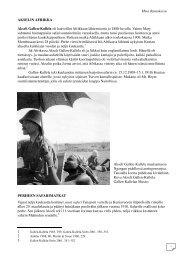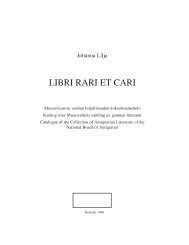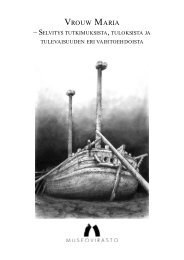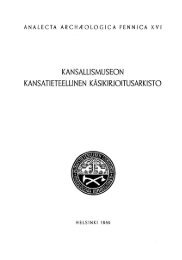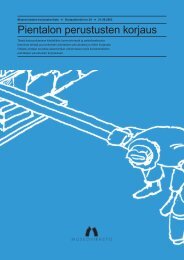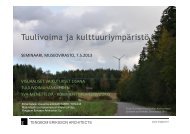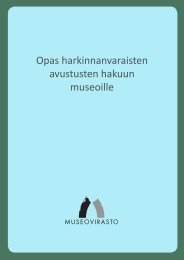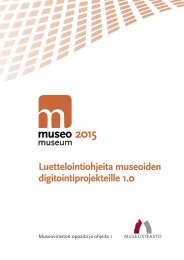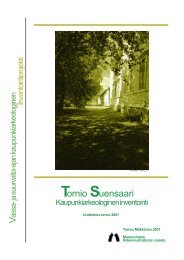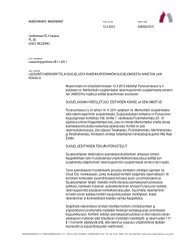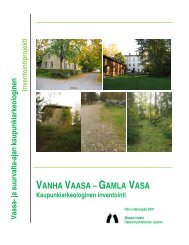Can we learn from the her it age lost in a fire? - Museovirasto
Can we learn from the her it age lost in a fire? - Museovirasto
Can we learn from the her it age lost in a fire? - Museovirasto
You also want an ePaper? Increase the reach of your titles
YUMPU automatically turns print PDFs into web optimized ePapers that Google loves.
Wooden towns are typical <strong>in</strong> all three countries (Rauma, F<strong>in</strong>land).<br />
2. Introduction<br />
2.1 The project<br />
The risk of <strong>fire</strong> is a serious concern especially<br />
<strong>in</strong> <strong>the</strong> Nordic countries, w<strong>her</strong>e <strong>the</strong><br />
major<strong>it</strong>y of historic build<strong>in</strong>gs are made<br />
of wood. The laws and practices for <strong>fire</strong> protection<br />
are <strong>we</strong>ll developed but <strong>the</strong> legislation does<br />
not usually specify <strong>the</strong> practices concern<strong>in</strong>g historic<br />
build<strong>in</strong>gs, so <strong>the</strong>re is need for cooperation to<br />
promote this po<strong>in</strong>t of view.<br />
As <strong>we</strong> have unfortunately had some serious<br />
<strong>fire</strong>s <strong>in</strong> historic build<strong>in</strong>gs <strong>in</strong> <strong>the</strong> Nordic countries,<br />
<strong>we</strong> thought that <strong>it</strong> might be possible to <strong>learn</strong><br />
someth<strong>in</strong>g <strong>from</strong> <strong>the</strong>m, such as how <strong>the</strong> <strong>fire</strong> started<br />
and how could <strong>it</strong> have been avoided. Ano<strong>the</strong>r<br />
question was whe<strong>the</strong>r <strong>fire</strong> fight<strong>in</strong>g caused any add<strong>it</strong>ional<br />
dam<strong>age</strong> to <strong>the</strong> build<strong>in</strong>gs and if <strong>it</strong> could<br />
have been avoided.<br />
T<strong>her</strong>e are some <strong>in</strong>structions on how to protect<br />
<strong>the</strong> ru<strong>in</strong>s of a build<strong>in</strong>g after a <strong>fire</strong> and <strong>the</strong>re<br />
are <strong>in</strong>ternational manuals for risk preparedness<br />
that deal w<strong>it</strong>h highly <strong>the</strong>oretical approaches to<br />
<strong>the</strong> measures to be taken after <strong>the</strong> <strong>fire</strong>. Ho<strong>we</strong>ver,<br />
<strong>the</strong>re is still a need for philosophical evaluation<br />
and discussion on “what to do after <strong>the</strong> <strong>fire</strong>”. In<br />
add<strong>it</strong>ion, <strong>the</strong>re is a need for practical <strong>in</strong>structions<br />
on what to do after a <strong>fire</strong> has taken place.<br />
The outcome of <strong>fire</strong>s may vary a lot, <strong>from</strong><br />
partial dam<strong>age</strong> to total devastation. Partial destruction<br />
raises difficult practical and ideological<br />
questions concern<strong>in</strong>g documentation, restoration<br />
and f<strong>in</strong>anc<strong>in</strong>g. Even <strong>in</strong> <strong>the</strong> more serious cases of<br />
destruction, <strong>the</strong>re may be methods of documentation<br />
that can secure at least some knowledge.<br />
The above formed <strong>the</strong> background for <strong>the</strong><br />
project, which consisted of three sem<strong>in</strong>ars dur<strong>in</strong>g<br />
2003. The first sem<strong>in</strong>ar took place <strong>in</strong> F<strong>in</strong>land <strong>in</strong><br />
May, <strong>the</strong> second <strong>in</strong> Norway <strong>in</strong> September, and<br />
<strong>the</strong> last one was held <strong>in</strong> S<strong>we</strong>den <strong>in</strong> November.<br />
The participants <strong>in</strong> <strong>the</strong> sem<strong>in</strong>ars had <strong>the</strong> opportun<strong>it</strong>y<br />
to discuss <strong>the</strong> practices of <strong>fire</strong> protection<br />
and <strong>the</strong> actions follow<strong>in</strong>g <strong>fire</strong>s <strong>in</strong> all <strong>the</strong> participat<strong>in</strong>g<br />
countries and <strong>the</strong>y <strong>we</strong>re able to <strong>learn</strong><br />
<strong>from</strong> each o<strong>the</strong>r’s experiences. We did not have<br />
sufficient time to go very deeply <strong>in</strong>to <strong>the</strong> details<br />
of <strong>fire</strong> protection but <strong>we</strong> did <strong>learn</strong> that <strong>the</strong>re are<br />
many ways to prevent a <strong>fire</strong> and to protect build<strong>in</strong>gs<br />
aga<strong>in</strong>st <strong>fire</strong>. The important aspects are that<br />
each historic build<strong>in</strong>g is unique and has to be<br />
treated accord<strong>in</strong>gly and that <strong>fire</strong> protection is a<br />
cont<strong>in</strong>uous activ<strong>it</strong>y that should be considered part<br />
of <strong>the</strong> normal ma<strong>in</strong>tenance of build<strong>in</strong>gs. Ano<strong>the</strong>r<br />
A stave church is a medieval type of build<strong>in</strong>g that is ma<strong>in</strong>ly preserved <strong>in</strong> Norway (28 churches).<br />
One stave church is also preserved <strong>in</strong> S<strong>we</strong>den.<br />
‹ 7



